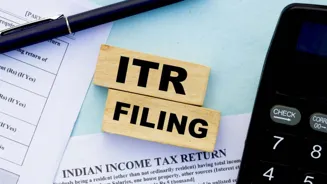Filing your income tax return (ITR) for the first time? While e-filing has become quicker and simpler, many first-time taxpayers still find the process intimidating. This step-by-step checklist will help
you understand who needs to file, which ITR form to choose, what documents to keep handy, and the deadline to avoid penalties.
1. Who needs to file an ITR?
You must file an ITR if your annual income crosses the taxable threshold or if you meet certain financial conditions — such as holding assets in India or abroad, having combined bank deposits over Rs 50 lakh, maintaining savings/current account balances above Rs 1 crore, paying electricity bills over Rs 1 lakh a year, spending more than Rs 2 lakh on foreign travel, investing in markets or ESOPs, or having sales worth more than Rs 60 lakh in a year.
2. Understanding taxable income
Your taxable income equals total earnings from salary and other sources (FD interest, shares, etc.) minus deductions allowed under the Income Tax Act. Deductions may include investments in PPF, NPS, life insurance, home loan interest, or rent paid.
3. Old vs. new tax regime
Choosing between the old and new tax regime depends on your income and eligible deductions. Use an online tax calculator or consult a CA to decide which option reduces your tax liability.
4. ITR filing deadline for FY 2024-25 (AY 2025-26)
The last date to file without penalty is September 15, 2025. You can file a belated return until December 31, 2025, but this attracts a penalty of Rs 1,000-Rs 10,000 depending on the delay and income.
5. Documents required
Keep ready: Form 16 from your employer(s), PAN, Aadhaar (linked), investment proofs, home loan interest certificate, and insurance premium receipts.
6. Form 16
A TDS certificate from your employer detailing salary, deductions, and exemptions — crucial for filing your return.
7. Form 26AS
Summarises income on which tax has been deducted; essential for cross-checking TDS credits.
8. Annual Information Statement (AIS)
Lists interest income, dividends, securities trades, and other transactions — much of which is auto-filled in your ITR form.
9. E-verification is mandatory
The income tax department requires e-verification within 30 days of filing. Skipping it can make your return invalid and delay refunds. Verification can be done using Aadhaar OTP, net banking, or an EVC.
10. Selecting the correct ITR form
ITR-1: For income from salary, one house property, and other sources.
ITR-2: For individuals/HUFs without business income.
ITR-3: For individuals/HUFs with business/professional income.
ITR-4: For presumptive income from business or profession.
For first-time filers, the right preparation — knowing the rules, collecting documents, and choosing the correct form — will make ITR filing smoother, faster, and penalty-free.














